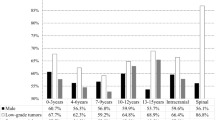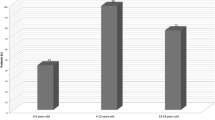Abstract
Object
The purpose of this study is to determine the epidemiology of tumors of the nervous system diagnosed according to the WHO 2000 classification in a single Brazilian institution.
Patients and method
One thousand one hundred ninety-five tumors in children between 0 and 21 years of age diagnosed between 1974 and 2003 were classified according the sex, topography, and age distribution.
Results
In all ages, males were slightly more affected. In the first 2 years, the prevalence for boys was higher (68.3%). In the whole series, 58.7% were supratentorial, 31.4% infratentorial, and 9.9% spinal (44% intra- and 56% extramedullary). Among these latter, ependymomas and schwannomas were the most frequent. In the cerebral compartment, pilocytic astrocytomas were the single most frequent tumors (18%), followed by diffuse astrocytomas (14%), medulloblastomas (11%), and craniopharyngiomas (11%). In the posterior fossa, there was an even distribution among medulloblastomas and pilocytic astrocytomas, but the former was much more frequent in the first 2 years of age. High-grade (III and IV) diffuse astrocytomas were slightly more frequent than low grades (II), and this difference becomes more evident as the child grows older. Due to the new development of the surgery of epilepsy, the frequency of neuronal and mixed neuronal–glial tumors is increasing (8%).
Conclusion
Classified according to the latest WHO classification, by a single neuropathologist in a single institution, this large series of pediatric neurological tumors may reflect fairly well their real incidence. Our results obtained in a developing country do not differ substantially from other similar series reported in the literature from the First World.





Similar content being viewed by others
References
Bleyer WA (1999) Epidemiologic impact of children with brain tumors. Childs Nerv Syst 15:758–763
Gurney G, Smith MA, Bunin GR (1999) CNS and miscellaneous intracranial and intraspinal neoplasms. National Cancer Institute SEER Pediatric monograph, pp 51–63
Kaatsch P, Rickert CH, Kuhl J, Schuz J, Michaelis J (2001) Population-based epidemiologic data on brain tumors in German children. Cancer 15:3155–3164
Kleihues P, Cavenee WK (2000) Tumours of the nervous system. World Health Organization classification of tumours. IARC Press, Lyon
Leviton A (1994) Principles of epidemiology. In: Cohen ME, Duffner PK (eds) Brain tumors in children, 2nd edn. Raven Press, New York, pp 27–49
McLendon RE, Provenzale J (2002) Glioneuronal tumors of the central nervous system. Brain Tumor Pathol 19:51–58
Miltenburg D, Louw DF, Sutherland GR (1996) Epidemiology of childhood brain tumors. Can J Neurol Sci 23:118–122
Nomura S, Nishizaki T, Yamashita K, Ito H (1998) Pediatric brain tumors in a 10-year period from 1986 to 1995 in Yamaguchi prefecture: epidemiology and comparison with adult brain tumors. Pediatr Neurosurg 28:130–134
Pollack IF (1994) Brain tumors in children. N Engl J Med 331:1500–1507
Prayson RA (2000) Papillary glioneuronal tumor. Arch Pathol Lab Med 124:1820–1823
Rickert CH, Probst-Cousin S, Gullotta F (1997) Primary intracranial neoplasms of infancy and early childhood. Childs Nerv Syst 13:507–513
Rickert CH, Paulus W (2001) Epidemiology of central nervous system tumors in childhood and adolescence based on the new WHO classification. Childs Nerv Syst 17:503–511
Rosemberg S, Vieira GS (1988) Tumor neuro-epitelial disembrioplástico. Um estudo epidemiológico de uma única instituição. Arq Neuro-Psiquiatr 56:232–236
Siffert J, Greenleaf M, Mannis R, Allen J (1999) Pediatric brain tumors. Child Adolesc Psychiatr Clin N Am 8:879–903
Sklar CA (2002) Childhood brain tumors. J Pediatr Endocrinol Metab 2:669–673
Smith MA, Freidlin B, Ries LA, Simon R (2000) Increased incidence rates but no space-time clustering of childhood astrocytoma in Sweden, 1973–1992: a population-base study of pediatric brain tumors. Cancer 15:1492–1493
Staneczec W, Janisch W (1994) Epidemiology of primary tumors of the central nervous system in children and adolescents. A population based study. Pathologe 15:207–215
Author information
Authors and Affiliations
Corresponding author
Rights and permissions
About this article
Cite this article
Rosemberg, S., Fujiwara, D. Epidemiology of pediatric tumors of the nervous system according to the WHO 2000 classification: a report of 1,195 cases from a single institution. Childs Nerv Syst 21, 940–944 (2005). https://doi.org/10.1007/s00381-005-1181-x
Received:
Revised:
Published:
Issue Date:
DOI: https://doi.org/10.1007/s00381-005-1181-x




